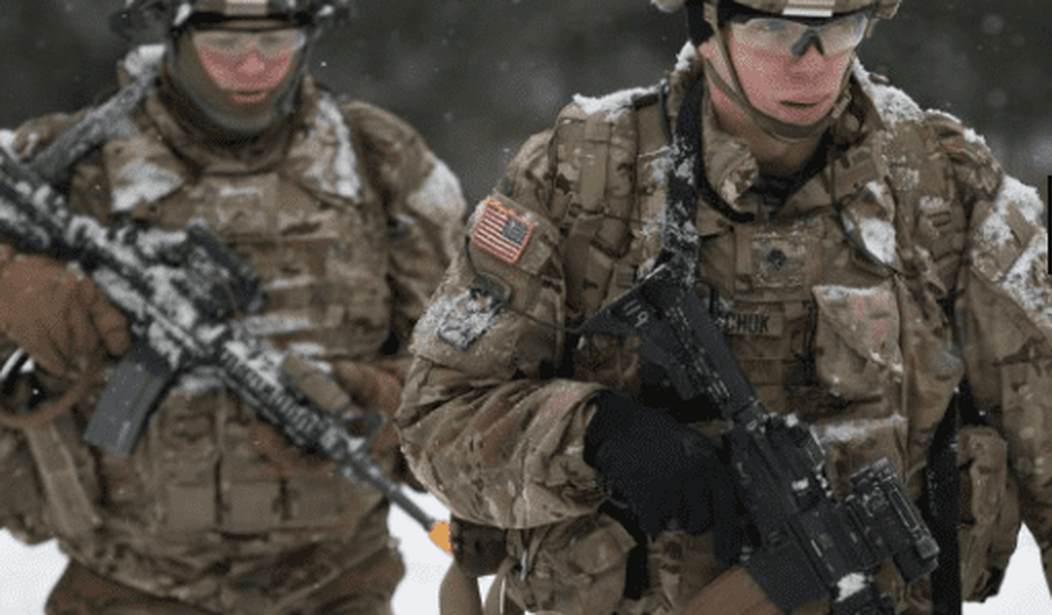An article last week in Popular Mechanics lamented the fact that today’s soldiers are being asked to carry ever-heavier loads of squad and personal equipment, even as advances in battlefield technology continue apace with modern warfare. Our friend Glenn Reynolds thought I might have something to say about this, and amazingly enough I do.
It seems odd to me that an entire article could be written about how heavier-than-ever kit must be carried by combat infantry without once using the word “stronger.” The actual weight of the components of battlefield munitions is examined in excruciating detail, from batteries to bullets, from body armor to water, from communications to medical gear, as are the efforts to minimize its weight through technology. Strategies to help soldiers carry increasing loads were listed — track vehicle “mules,” motorized exoskeletons, and various robotic options are discussed, but by the end of the piece no plans for dealing with the problem had been announced. It was observed that “[a] soldier carries 100 pounds of the lightest kit imaginable.”
The fundamental problem here is quite simple, as is its solution: Soldiers are not strong enough to carry a heavier kit, and as long as military physical training remains rooted in pushups, situps, and running, PT will be inadequate to the task of producing a stronger soldier. The solution is to address basic training from a strength approach and to leave subsequent conditioning to the discretion of the company command team based on the needs of their unit’s assignment. Essentially all of it now is conditioning, with no barbell strength requirement in place at the basic training level.
To be sure, the Army seems to understand that it should address this problem. But their response has been typical of a military bureaucracy: leave 90% in place and take the lowest bid on the 10% that gets the chop. My suggestion is quite radical, highly effective, quite inexpensive, immediately productive, easily implemented, safer than endurance-based training, and as a result will never even be considered. I’ll share it with you.
The vast majority of military recruits are young men. These people are plagued with poisonous levels of natural testosterone. Instead of running them into the ground, let’s make them stronger by implementing a correctly designed and performed barbell-based strength program as the primary PT modality for basic training.
It is perfectly normal to take an 18-year-old kid from no deadlift at all to 400 pounds in six months, with comparable increases in all the other strength indices. This will be accompanied by an increase in useful muscle mass of anywhere from 20 to 30 pounds. I have done it professionally for 40 years, and it is not complicated if you understand the simple accumulative effect of adding five pounds to an exercise performed three days per week. If you have absolute control over the training and dietary environment of an 18-year-old kid — as you do in basic training — there is absolutely no reason why every male in the military cannot become at least two or three times as strong as they are under the current paradigm.
Barbells are very cheap. They don’t use a lot of space. They are far more portable than exercise machines. Each barbell has multiple functions — they are not single-purpose devices. They are easy to learn how to use, and they are relatively easy to learn how to coach. They are quite a bit safer to use if properly implemented. Stress fractures are quite common among runners and virtually unheard of in barbell training, and in the military they are the equivalent of low-back pain in the general population. The DoD spends about $500 million per year on musculoskeletal injuries, about 80% of which are overuse injuries like stress fractures. The hilarious thing is that strength training specifically prevents these types of injuries, even though the conventional wisdom holds that it is dangerous.
Conditioning develops very quickly, whereas strength takes time. Moving two miles with a 100-pound kit is a strength performance in that each step is a submaximal display of strength. It should be obvious that a 400-pound deadlift translates into a much easier two-mile transit than a 200-pound deadlift would enable. Since conditioning comes on quickly (ever hear of two-a-days?), if we need to train for it within a short time frame we can. Strength takes longer, but it lasts longer once it’s acquired, and so it should be prioritized since it enables ground combat personnel to function more effectively.
Modern soldiers are not runners, or even walkers anymore. Mechanization has taken the place of the 20-mile march. But it is very important to understand that a strength-trained 18-year-old kid can still run quite effectively without wasting time by running as PT. You all know a strong kid who can run anyway. He can run accidentally. He doesn’t need to waste time running when he can be training for the much more useful capacity of strength.
If Heavy is the problem, Strong is the solution. And you don’t get strong while running. We are wasting the strength potential of every man in the service by misunderstanding the nature of this problem. It can be addressed by the systematic application of the correct PT. Unfortunately, I’m not in charge.









Join the conversation as a VIP Member